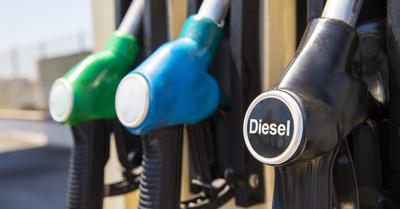We've all seen the more familiar clear diesel fuel at our local gas stations, but what exactly is red-dyed diesel, and who should use it?
Red-dyed diesel, also known as off-road diesel or farm fuel, is a unique type commonly used in heavy machinery, agricultural equipment, and generators. It's essentially ultra-low sulfur diesel (ULSD) treated with a distinctive oil-soluble red dye for identification purposes.
Whether you're a farmer, construction site manager, or just a curious reader, this comprehensive guide will help you understand everything you need about red-dyed diesel. This special type of fuel, marked by its distinctive red color, plays a significant role in various sectors, from agriculture to construction and even home heating.
Key Takeaways
- Red-dyed diesel is regular diesel fuel with red dye to indicate its use for off-road vehicles.
- Red-dyed diesel has more sulfur than clear diesel, and it’s not taxed the same.
- Performance-wise, clear diesel, and red-dyed diesel are essentially the same, but you cannot use red-dyed diesel on traditional roads.
This article may contain affiliate links where we earn a commission from qualifying purchases.
What Is Red Dyed Diesel?
Red-dyed diesel fuel, also known as red diesel, red fuel, farm fuel, and off-road diesel, is essentially the same ultra-low sulfur diesel (ULSD) found at local filling stations.
The primary difference is the addition of an oil-soluble red dye for identification purposes, ensuring it's used for off-road vehicles and other applications like farming.
The main reason for dyeing the fuel red is to differentiate tax-exempt fuels like red diesel from taxed on-road diesel fuel. This was initiated in 1994 when the U.S. government passed 26 C.F.R. 48.4082-1, a regulation that controls the use of red dye in tax-exempt diesel fuels, including kerosene.
When it comes to performance, there isn't any significant difference between red-dyed diesel and clear or slightly green on-road diesel. Both fuels are ULSD and serve their intended purposes effectively.
However, it's essential to remember that using red-dyed diesel for on-road vehicles is illegal and can result in hefty fines for evading fuel taxes.
Red Dyed Diesel Fuel vs. Regular Diesel
Red-dyed and regular diesel are two of the most common types. There is also blue-dyed diesel and green diesel, but we will only focus on comparing these two diesel fuels below.
Purpose and Usage
Red-dyed diesel, often called off-road diesel, is specifically designed for use in vehicles and machinery that do not operate on public roads. This includes farm equipment, construction machinery, generators, and home heating systems.
On the other hand, regular diesel is intended for vehicles that are driven on public roads, such as cars, trucks, and buses. This includes marine vehicles and government vehicles too.
Taxation and Pricing
The major difference between red-dyed diesel and regular diesel is their tax status. Red-dyed diesel is tax-exempt, as it is not subject to the federal, state, or local road taxes that regular diesel incurs.
This exemption is because red-dyed diesel is not intended for use on publicly maintained roads. Consequently, red-dyed diesel is significantly cheaper than regular diesel. Regular diesel, subject to various taxes, costs more at the pump.
Regulations and Enforcement
Due to its tax-exempt status, red-dyed diesel is strictly regulated. Using it on regular roads is considered a form of tax evasion and is, therefore, illegal.
Authorities can conduct random checks to ensure compliance, siphoning a small amount of fuel from a vehicle's tank for visual inspection. If red diesel is discovered in an on-road vehicle, the owner can face substantial fines.
Because of these rules, Distributors cannot knowingly transport dyed fuel with the intent to sell it as regular on-road fuel. In contrast, there are no such restrictions on regular diesel. Any vehicle, on-road or off-road, can legally use regular diesel.
Performance and Efficiency
Red-dyed diesel and regular diesel offer similar performance levels and fuel efficiency, given they are essentially the same product.
The red dye added to off-road diesel does not affect the fuel's properties or combustion efficiency. Therefore, both fuel types provide the same amount of energy per gallon and generate similar emissions.
Environmental Impact
Both red-dyed diesel and regular diesel have comparable environmental impacts. The emissions from burning diesel fuel include particulates and nitrogen oxides, which contribute to air pollution and climate change.
Can Red-Dyed Diesel Damage Your Engine?
Red-dyed diesel will not harm your engine or any other vehicle part. Red diesel is essentially the same as regular diesel but with a red dye added to it to differentiate it from on-road diesel fuel.
It's essential to mention that the red dye is only added for identification purposes, signaling that the diesel is for off-road use and is not taxed like regular consumer motor fuel.
So, the only difference between them is the addition of a special red dye, such as Solvent Red 26 or Solvent Red 164, to designate its off-road usage. However, there is one crucial aspect to consider.
If red diesel contains a high sulfur content, it should not be used in modern engines designed for ultra-low sulfur diesel (ULSD). So, as long as the red diesel isn't laced with high sulfur content, it won't cause any harm to your engine.
Can You Remove The Dye From Red Diesel?
Yes, removing the red dye from diesel fuel is possible, but we don't recommend attempting this process. Various methods can be used, such as filtering the fuel through a granulated activated carbon filtration column or using a reverse osmosis system.
However, removing the dye presents several challenges and risks. First, the process can be both time-consuming and prone to errors. Additionally, red diesel is intended for use in off-road vehicles and machinery, and using it may lead to legal consequences.
This is a common fraud tactic to pay lower prices for fuel and sell it at a higher price to increase profits. We recommend against ever removing the red dye from your diesel.
Attempting to remove the dye might not eliminate the sulfur content, which can lead to potential engine problems if not treated properly. Consequently, trying to remove the dye can prove to be counterproductive.
What Happens If You Use Red Dyed Diesel On Roads?
Red-dyed diesel, also known as off-road diesel, is primarily intended for use in heavy equipment and off-road vehicles. This fuel is similar to regular diesel but contains a red dye for identification purposes.
Using this fuel on regular roads is illegal in most states. Violating this law can result in hefty fines - typically $10 per gallon or $1000 per violation, whichever is greater. The red dye is designed to be easily detected by government officials during inspections.
It is strongly advised to use regular diesel for regular driving, as the red dye might void your warranty or cause issues with some engine components. And you will pay regular fines because of the dyed diesel regulations.
Getting caught driving on the highway with dyed diesel fuels could also result in vehicle or license restrictions. It’s also harder to find fuel stations that carry dyed diesel.









